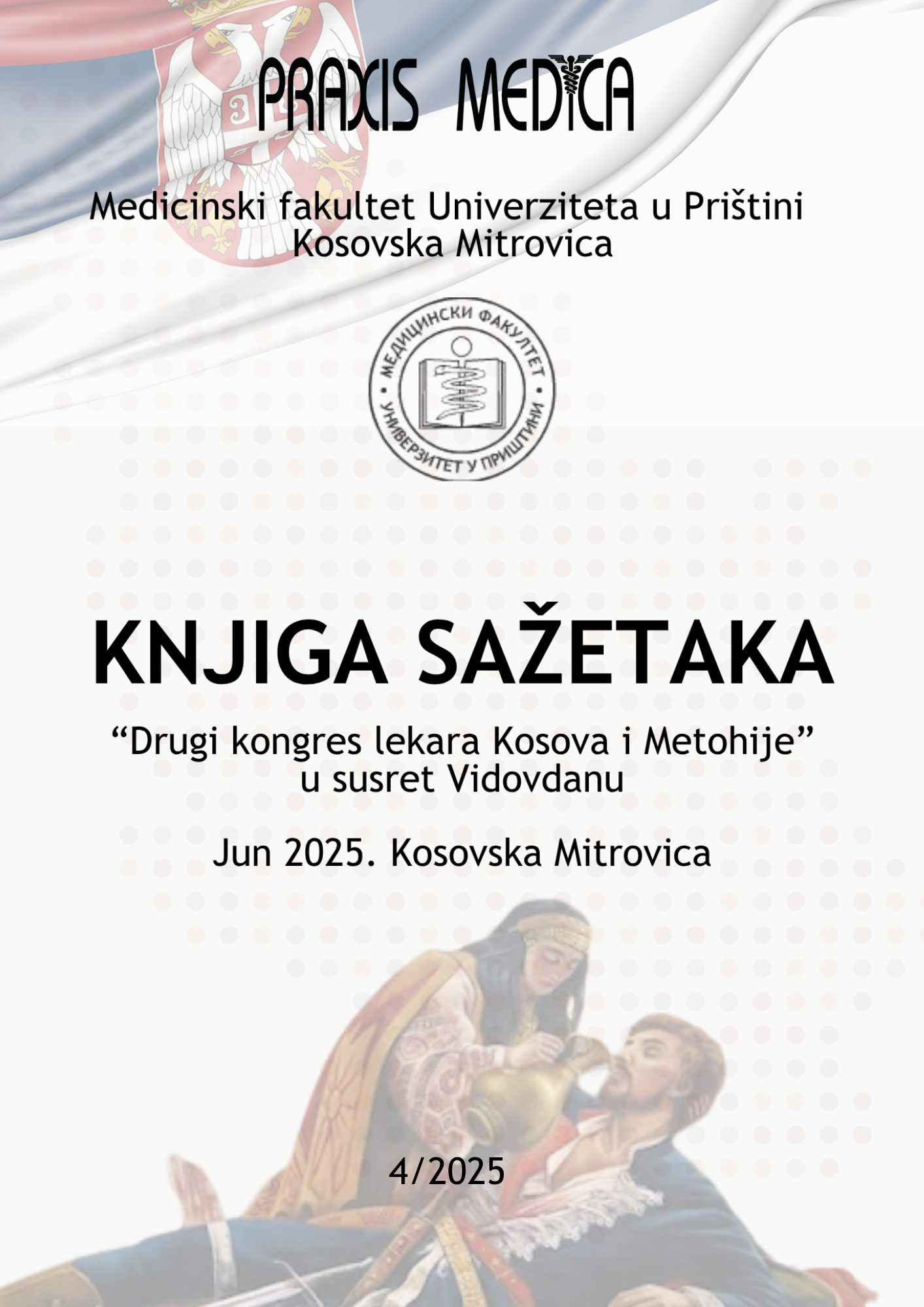Current issue

Volume 53, Issue 4, 2025
Online ISSN: 2560-3310
ISSN: 0350-8773
Volume 53 , Issue 4, (2025)
Published: 30.06.2025.
Open Access
All issues
Contents
30.06.2025.
Professional paper
TELOCITI DVE DECENIJE NAKON OTKRIĆA: POREKLO, IMUNOHISTOHEMIJSKI BIOMARKERI, DISTRIBUCIJA I FUNKCIJA U ZDRAVLJU I BOLESTI
Introduction: Telocytes (TCs) represent a novel type of interstitial cell discovered in 2005 by Romanian scientist Laurentiu Popescu, and they are the
only known human cells identified in the 21st century. Initially classified as interstitial Cajal-like cells, they were renamed telocytes in 2010.
Main Body: Their defining morphological feature is the presence of extremely long and slender extensions called telopodes, which can reach lengths
of several hundred micrometers and exhibit an uneven, moniliform appearance that distinguishes them from other cell types. Identification of TCs
relies on a combination of immunohistochemical techniques and transmission electron microscopy (TEM), which remains the gold standard. Commonly
used immunohistochemical markers include combinations such as CD34/vimentin, CD34/PDGFRα, and CD34/c-kit.
Telocytes exhibit variable cell body shapes (pyriform, spindle-shaped, or triangular) depending on the number of telopodes (usually 1–5 per cell).
Their cytoplasm is sparse, with a prominent nucleus occupying about 25% of the cell volume, and contains mitochondria, a small Golgi complex, rough
and smooth endoplasmic reticulum, and cytoskeletal components. Originally identified in the intestinal tract, TCs have since been found in almost all
human organs – including the heart, blood vessels, lungs, skin, salivary glands, liver, gallbladder, pancreas, kidneys, urinary bladder, myometrium,
prostate, and others. They reside in the interstitial tissue, where they interact with stromal and immune cells as well as blood vessels, suggesting a
crucial role in maintaining tissue microenvironment homeostasis.
Functionally, TCs are involved in tissue regeneration, mechanical support, and immune modulation. They also contribute to stem cell niche
maintenance and signal transduction, both through direct cell–cell contacts and via paracrine signaling mediated by extracellular vesicles. Alterations
in telocytes have been reported in various inflammatory and fibrotic diseases, including ulcerative colitis, Crohn’s disease, hepatic fibrosis, psoriasis,
and systemic sclerosis. These structural and functional changes are collectively referred to as “telocytopathies.” The potential role of TCs in
tumorigenesis has led to the proposal of the term “telocytoma” for tumors of possible telocyte origin. Gastrointestinal and extra-gastrointestinal
stromal tumors, as well as tumors of the uterus, prostate, and vagina, share expression of TC markers such as PDGFRα and c-kit.
Conclusion: Despite increased research activity in the years following their discovery, numerous questions remain unanswered – including whether
telocytes constitute a homogeneous or heterogeneous cell population, which specific markers define TCs in different organs, and what their precise
roles are in neoplastic and non-neoplastic conditions. A deeper understanding of TC biology could pave the way for novel diagnostic and therapeutic
strategies in a variety of pathological conditions.
Keywords: telocytes, telopodes, interstitial cell, telocytopathies
Snežana Leštarević
01.12.2020.
Professional paper
Respiratory epithelium: Place of entry and / or defense against SARS-CoV-2 virus
Coronavirus Disease (COVID-19) is caused by the RNA virus SARS-CoV-2. The primary receptor for the virus is most likely Angiotensin-converting enzyme 2 (ACE2), and the virus enters the body by infecting epithelial cells of the respiratory tract. Through the activation of Toll Like Receptors (TLRs), epithelial cells begin to synthesize various biologically active molecules. The pathophysiology of the COVID 19 is primarily attributed to the hyperactivation of host's immune system due to direct damage to the cells, with consequent release of proinflammatory substances, but also due to the activation of the innate immune response through the activation of alveolar macrophages and dendrite cells (DC). A strong proinflammatory reaction causes damage to alveolar epithelial cells and vascular endothelium. Respiratory epithelial cells, alveolar macrophages and DC are likely to be the most important cells involved in the innate immune response to the virus, since prolonged and excessive SARS-CoV-2-induced activation of these cells leads to the secretion of cytokines and chemokines that massively attract leukocytes and monocytes to the lungs and cause lung damage.
Snežana Leštarević, Slađana Savić, Leonida Vitković, Predrag Mandić, Milica Mijović, Mirjana Dejanović, Dragan Marjanović, Ivan Rančić, Milan Filipović
01.12.2019.
Original scientific paper
HISTOLOGICAL CHARACTERISTICS AND VOLUME DENSITY OF ELASTIC FIBERS IN THE DERMIS DURING AGING
Introduction: Elastic fibers are constituents of the dermal extracellular matrix, determining the histoarchitecture of the
dermal connective tissue. Organization and density of elastic fibers change as skin ages. The aim of this paper was to determine the similarities and differences between the photo-aging and the physiological aging of skin by examining organization and quantifying the elastic fibers in the dermis during aging. The material included samples of photoexposed and photoprotected skin, obtained from 90 cadavers aged 0-82 years. The samples were classified into five age groups: newborns, young age, middle age, mature age and the oldest age. Skin samples were stained using the Halmi modification of Aldehyd fucshin staining method, as well as Alcian blue staining (the Spicer method). Volume density (VD) of the elastic fibers was measured using Image J program.
Results: In the skin of newborns and young age group (neck and abdomen) elastic fibers appeared to form a network structure. In the photoexposed skin of the mature age and the oldest group, elastic fibers showed tendency to fragment, while the elastic material exhibited tendency to accumulate. VD of elastic network in the skin of the neck in the middle, mature and the oldest age group was greater than VD of abdominal skin of the respective age groups (3.66±0.28%, 5.61±0.22%, 6.24±0.21% respectively). Age-related statistically significant increase in VD of the elastic network in the skin of the neck, as well as a statistically significant reduction of elastic network VD in the abdominal skin, has been observed (middle age - oldest).
Conclusion: Correlation of the organization and quantity of elastic fibers with age exhibits different pattern in photoexposed compared to photoprotected skin. A quantitative evaluation of the volume density of elastic fibers correlates with clinically visible signs of photo-aging, primarily with solar elastosis.
Snežana Leštarević, Predrag Mandić, Milica Mijović, Mirjan Dejanović, Dragan Marjanović, Suzan Matejić, Milan Filipović





